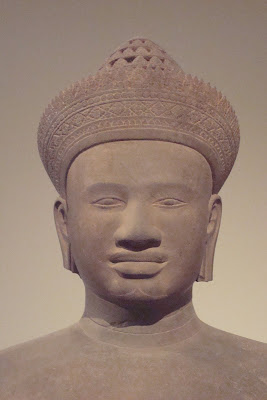
balustrade from Preah Khan Temple in Angkor
The Guimet Museum in Paris has one of the finest collections of Khmer art, not surprising considering the long French rule over the country and the important role played by the French Institute of the Far East (Ecole Francaise d’Extreme-Orient) in uncovering and restoring many of Cambodia’s archaeological wonders.
At the very entrance to the main hall with Khmer art is a piece from the balustrade to the Preah Khan temple complex at Angkor, which was consecrated in 1191. It consists of a Naga being pulled by Devas and Asuras, from the Hindu Churning of the Ocean of Milk. This is taken from the Preah Koh temple in Angkor Thom. This image was brought to France for the Paris expo of 1900, where it evoked considerable interest in Cambodian art among the French.

Lintel from Bantey Srei
The magnificent lintel of the Bantey Srei temple depicting the battle between the demons Sunda and Upasunda over Tilottama (an episode from Mahabharata)occupies a pride of place in the main hall for Khmer art at Guimet. Apparently, it had to be brought to France because it could not be restored back at its original site by French archaeologists.

Hindu Trinty from Phnom Bok
The other magnificent collections at Guimet includes the images of the Hindu Trinity, Brahma, Visnhu and Shiva found at the site of Phnom Bok temple built at the beginning of the 10th century. These may be the finest images of the trinity in entire findings of Khmer art that survives to date anywhere.

Shiva Image
In addition, there are numerous Shiva and Buddha images at Guimet. Buddhism flourished under Jayavarman VII, Angkor’s most powerful emperor who built the Angkor Thom and Bayan complexes.

Buddha Image
The Guimet collection shows an intimate link between art and politics or ancient Cambodia. The variety of artistic styles and schools during pre-Angkoran time (6-8 century), reflects the break up of Cambodia. Styles represent different regions. One example is Harihara in Phnom Da Style, from the pre-Angkor period .

Harihara in Phnom Da Style
The Kulen style at the beginning of the Angkoran period can be found throughout Cambodia, suggesting the influence of a centralised government.
Koh Ker Style: reflects the abandonment of Angkor as capital for a provincial capital by Jayavarman IV (920-940AD), marked by colossal powerful statues. A magnificent example is the image of Brahma found from Wat Baset in Battambang Province done in Koh Ker style

Jayvarmana and Jayarajadevi
And what can provide a better example of the political nature of Khmer art can be collection at Guimet than the images of Jayavarman VII and his first queen Jayarajadevi (to be provided) appearing as a prajnaparamita or Tara of the Mahayan pantheon.
Source: Personal visit 25th September 2008; Pocket Guide (Guimet Musee National des Arts Asiatiques,, 2001)
No comments:
Post a Comment